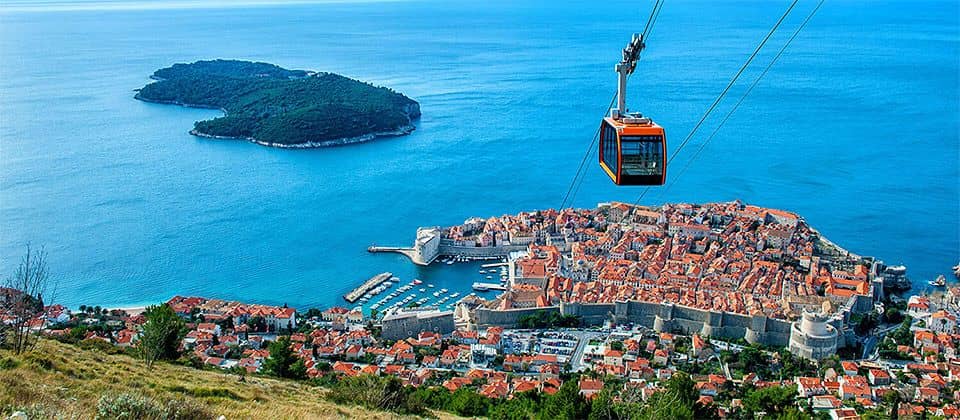Best Tourist Attractions and things to do in Dubrovnik
Dubrovnik enchants visitors with it magnificent city walls, fortresses, numerous sacral objects , museums and other sightseeing possibilities.
Because of its monumental walls and well preserved cultural monuments, Dubrovnik has been included in UNESCO's Register of World Architectural Heritage in 1979.
In the region itself there are 168 protected historical sites, traditional settlements, 1436 protected historical buildings, churches, monasteries and other complexes... plus, a whole region of landscapes with historical features. After you’ve explored all that Dubrovnik has to offer, we suggest also checking out some of the Best day trips from Dubrovnik.
Dubrovnik Super Saver:
Cable Car Ride and Old Town Walking Tour plus City Walls
Embark on an unforgettable journey through the stunning city of Dubrovnik, renowned for its breathtaking architecture and rich history. Stroll along the narrow and winding streets of the UNESCO World Heritage Site of Dubrovnik Old Town. Be awe-inspired by the mesmerising views from the 16th-century city walls, and take your experience to the next level by taking a cable car ride to Mt. Srd for panoramic views of the city.
Book your tour now and discover Dubrovnik with a knowledgeable tour expert.

From Srđ hill, without doubt, you have the most beautiful view of Dubrovnik, Island Lokrum and the surrounding area.
- Details
- Written by: Orsat Munitić
Fort Lovrijenac is the dramatic cliff-top fortress you see in almost every classic view of Dubrovnik, perched 37 meters above the sea on a rocky outcrop just outside the Old Town walls. From its terraces you get some of the best views of the city and the Adriatic, making it an easy must-do alongside the City Walls.
Today the fortress mixes history, culture and pop culture: it once guarded the western approach to the city, now hosts performances during the Dubrovnik Summer Festival and doubled as the Red Keep in Game of Thrones.
Watching Romeo and Juliet at Fort Lovrijenac during the Dubrovnik Summer Festival, I remember climbing up the steep stone steps at sunset, buzzing with excitement. Once the play began, the view over the glowing Old Town and the dark sea behind the stage made it feel like the whole fortress was part of the story, not just a backdrop.
- Details
- Written by: Orsat Munitić
Read more: Fort Lovrijenac (St Lawrence Fortress), Dubrovnik
The aquarium is located on the ground floor of the 700 year old St John's fortress on the southeastern side of the old city port of Dubrovnik and is stocked with various sea life.
- Details
- Written by: Orsat Munitić
Passing through the large »Vrata Ribarnice« built in the 14th century at the end of Stradun, you enter the Old Town Dubrovnik Port. The port is surrounded by Porporela breakwater located in front of St. John fortress, and Kaše breakwater that extends perpendicular across the bay of the port.
- Details
- Written by: Joomla
The Dubrovnik City Walls were built from the 13th to the 18th century, constantly added to and strengthened, without ever having to be used for the purpose for which they were built, thanks to the skilful diplomacy of Dubrovnik.
- Details
- Written by: Orsat Munitić
At the very end of Stradun, on its north-east side, the most splendid profane building, the Sponza palace, was built in the period from 1516. to 1521. as a commercial centre of medieval Dubrovnik with a mint, a Custom-House, a weights and measures office, etc.
- Details
- Written by: Orsat Munitić
Discover the history of the Dubrovnik Republic on this magnificent replica of the 16th century traditional carrack.
- Details
- Written by: Orsat Munitić
After entering Dubrvnik Old town trough Pile gate, immediately on your right hand side you will see the polygonal Onofrio Fountain.
- Details
- Written by: Orsat Munitić
Opposite to the Sponza palace (Divona) there is a church dedicated to the patron saint of Dubrovnik, St. Blaise (Sv. Vlaho). It was erected in 1715. in the Venetian baroque style, and it is the work of the well-known Italian architect Gropelli.
- Details
- Written by: Orsat Munitić
The Rector's palace is one of the most impressive buildings in Old Town Dubrovnik and of great historic and artistic value.
- Details
- Written by: Orsat Munitić
The Assumption Cathedral is a Roman Catholic cathedral and the seat of the Diocese of Dubrovnik.
- Details
- Written by: Orsat Munitić
The Church of Holy Savior in Dubrovnik was built in the 16th century by Senate's order in gratitude of "mountain Srđ not falling down" during the great earthquake in 1520.
- Details
- Written by: Orsat Munitić
Stradun is the biggest, longest and widest street in Old Town Dubrovnik. This street, 292 meters long, is the commercial, entertainment and spiritual centre of Dubrovnik.
- Details
- Written by: Orsat Munitić
Trough this Gate, the French army led by Napoleon entered Ragusa 1806. Soon after, the Dubrovnik Republic was abolished.
- Details
- Written by: Orsat Munitić
St Ignatius’ Church is a part of a stunning complex on the southern edge of Dubrovnik.
- Details
- Written by: Orsat Munitić
The "Street of the Wells" runs parallel to the Placa (Stradun) with its entire length.
- Details
- Written by: Orsat Munitić
The Serbian Orthodox Church of Saint Annunciation was built in 1877. for only 300 members of the community then living in Dubrovnik.
- Details
- Written by: Orsat Munitić
A the end of the Old port in Dubrovnik, there is a pier with a red beacon at the end. A lovely place to sit and think.
- Details
- Written by: Orsat Munitić
The story tells that the Synagogue in Dubrovnik was established in 1352. but gained legal status in 1408. which makes it the oldest Sefardic synagogue in use in the world and the second oldest synagogue in Europe.
- Details
- Written by: Orsat Munitić